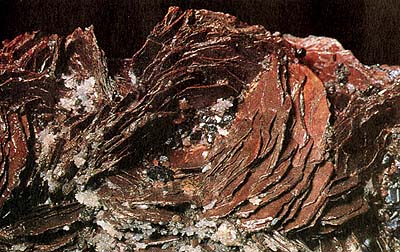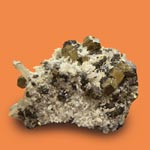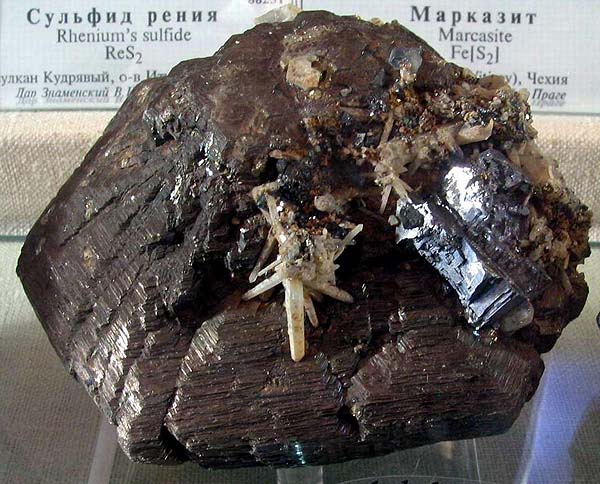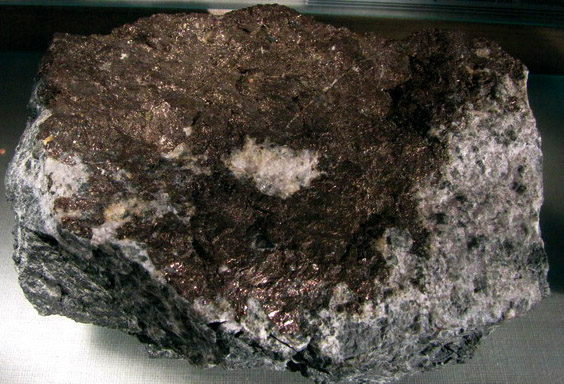Sulfides: Pyrrhotite
 Diagnostic Card.
Diagnostic Card.
Two forms of pyrrhotite crystals: tabular form (right); lamellar aggregates (bottom)
Fe S
Crystal system hexagonal
Hardness 3.5-4.5
The proportion of 4.5-4.7
Cleavage is perfect
The break in the wrong
The color is reddish-yellow
Color powder gray-black
shine metal

 Pyrrhotite (pyrrhotite) - iron sulfide. Shine metal with dull tarnish; opaque. Color bronze-yellow. Dash grayish black. Fracture conchoidal, uneven. Fragile. Cleavage is perfect, magnets.
Pyrrhotite (pyrrhotite) - iron sulfide. Shine metal with dull tarnish; opaque. Color bronze-yellow. Dash grayish black. Fracture conchoidal, uneven. Fragile. Cleavage is perfect, magnets.
It is found in magmatic deposits, associated with the basic structure of rocks, rarely in pegmatites, skarns and hydrothermal deposits. The crystals (hexagonal system) are rare; they are lamellar, tabular or columnar, often grouped in rosettes: more common in dense aggregates: coarse-grained, fine-grained or discharge, sometimes foliated. Distribution Locations: Germany, Finland, Norway, Yugoslavia, South Africa, Canada, CIS.
Pyrrhotite occurs as tabular crystals, but the most common - grained massive aggregates. Its characteristic color on fresh surfaces - reddish-yellow or bronze-yellow, the air turns brown. Shine metal. Opaque. Quite often covered with an iridescent film.
Chemical composition-content (%): S - 36,4-40; Fe - 60-63,6; sometimes marked admixture of copper, nickel, cobalt. Digeksagonalno-dipiramidalny kind of symmetry. Cleavage - imperfect at (1010). It occurs usually as solid masses impregnated grains or irregular shape. Crystals are rare, typical plate, columnar, bochonkovidny shape with facets pinacoid (0001), the prism (1010), dipyramids (1011) and (2021), known as twins and tees for the (1011).
Diagnostic features.
For pyrrhotite characteristic magnetic properties; it easily melts, forming a black mass, also strongly magnetic.
Origin.
The mineral is typical of magmatic segregation. Formed primarily in the solidification of intrusive mafic and ultramafic rocks (rich in iron and magnesium). In this type of field is always associated with pyrrhotite minerals nickel and cobalt, which have economic value. It may also be of hydrothermal origin, but such pyrrhotite are never nickel.

Deposits and application.
Huge deposits of pyrrhotite found in Sudbury, Manitoba (Canada). Other significant deposits are found in Mexico, Bolivia, Brazil, Norway and Sweden. Pyrrhotite, if he is devoid of impurities, no commercial value is not. Conversely, if it is enriched with nickel, cobalt or platinum, its economic importance as ores these elements is extremely high. Pyrrhotite - one of the very few magnetic minerals. It plays an important role in the production of iron sulphate and crocus.





Pyrrhotite. Nicholas district to, Dalnegorsk, Primorye, Russia. Photo: © AA Evseev.

Pyrrhotite. Massive veins in okoloskarnovom hornfels and quartz.
Grand Canyon, the Magadan Region., Russia, CIS. More than 10 cm Photo:. © AA Evseev.
- Gatchell - "New Almadén snag" - arsenide and antimony sulfide (modern sulphosalts)
- Antimony - toxic metal (semi-metal) are widely used in industry, medicine and engineering
- Zirconium - a rare and non- metal and dangerous jewel in the oxide and salts
- Gold - yellow dangerous and toxic metal -date and accurate digital cable technology
- Sulphur - a golden-yellow toxic substance and a sign of volcanic activity
- Cadmium - a toxic uncirculated unknown wide range of people silvery metal
- Lead - a poisonous gray simulator silver metal and toxic metal snag
- Arsenic - poison classic medieval and modern poisoners and medicine in medicine
Toxic and hazardous radioactive rocks and minerals
** - Poisonous stones and minerals (obligatory check in chemical laboratory + clear indication of toxicity)
** - Radioactive rocks and minerals (obligatory check on a regular dosimeter + ban on the open sale of radioactivity in the event of more than 24 mR / hour + additional measures to protect the population)
Catalog minerals and gems in groups of the world
** - Poisonous stones and minerals
** - Radioactive rocks and minerals


Comments
Commenting, keep in mind that the content and the tone of your messages can hurt the feelings of real people, show respect and tolerance to his interlocutors, even if you do not share their opinion, your behavior in terms of freedom of speech and anonymity offered by the Internet, is changing not only virtual, but real world. All comments are hidden from the index, spam control.